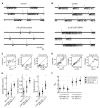Impairment of GABA transporter GAT-1 terminates cortical recurrent network activity via enhanced phasic inhibition
- PMID: 24062646
- PMCID: PMC3769619
- DOI: 10.3389/fncir.2013.00141
Impairment of GABA transporter GAT-1 terminates cortical recurrent network activity via enhanced phasic inhibition
Abstract
In the central nervous system, GABA transporters (GATs) very efficiently clear synaptically released GABA from the extracellular space, and thus exert a tight control on GABAergic inhibition. In neocortex, GABAergic inhibition is heavily recruited during recurrent phases of spontaneous action potential activity which alternate with neuronally quiet periods. Therefore, such activity should be quite sensitive to minute alterations of GAT function. Here, we explored the effects of a gradual impairment of GAT-1 and GAT-2/3 on spontaneous recurrent network activity--termed network bursts and silent periods--in organotypic slice cultures of rat neocortex. The GAT-1 specific antagonist NO-711 depressed activity already at nanomolar concentrations (IC50 for depression of spontaneous multiunit firing rate of 42 nM), reaching a level of 80% at 500-1000 nM. By contrast, the GAT-2/3 preferring antagonist SNAP-5114 had weaker and less consistent effects. Several lines of evidence pointed toward an enhancement of phasic GABAergic inhibition as the dominant activity-depressing mechanism: network bursts were drastically shortened, phasic GABAergic currents decayed slower, and neuronal excitability during ongoing activity was diminished. In silent periods, NO-711 had little effect on neuronal excitability or membrane resistance, quite in contrast to the effects of muscimol, a GABA mimetic which activates GABAA receptors tonically. Our results suggest that an enhancement of phasic GABAergic inhibition efficiently curtails cortical recurrent activity and may mediate antiepileptic effects of therapeutically relevant concentrations of GAT-1 antagonists.
Keywords: GABA receptor; GABA reuptake; GABA transporter; NO-711; SNAP-5114; phasic inhibition; spillover; tonic inhibition.
Figures








Similar articles
-
Subtype-specific GABA transporter antagonists synergistically modulate phasic and tonic GABAA conductances in rat neocortex.J Neurophysiol. 2005 Sep;94(3):2073-85. doi: 10.1152/jn.00520.2005. Epub 2005 Jun 29. J Neurophysiol. 2005. PMID: 15987761
-
GAT-3 transporters regulate inhibition in the neocortex.J Neurophysiol. 2005 Dec;94(6):4533-7. doi: 10.1152/jn.00420.2005. Epub 2005 Aug 31. J Neurophysiol. 2005. PMID: 16135550
-
Role of GABA transporter 3 in GABAergic synaptic transmission at striatal output neurons.Synapse. 2009 Oct;63(10):921-9. doi: 10.1002/syn.20675. Synapse. 2009. PMID: 19588470
-
GABA transporter heterogeneity: pharmacology and cellular localization.Neurochem Int. 1996 Oct;29(4):335-56. doi: 10.1016/0197-0186(95)00158-1. Neurochem Int. 1996. PMID: 8939442 Review.
-
Pathophysiological power of improper tonic GABA(A) conductances in mature and immature models.Front Neural Circuits. 2013 Oct 24;7:170. doi: 10.3389/fncir.2013.00170. eCollection 2013. Front Neural Circuits. 2013. PMID: 24167475 Free PMC article. Review.
Cited by
-
Zolpidem Activation of Alpha 1-Containing GABAA Receptors Selectively Inhibits High Frequency Action Potential Firing of Cortical Neurons.Front Pharmacol. 2019 Jan 9;9:1523. doi: 10.3389/fphar.2018.01523. eCollection 2018. Front Pharmacol. 2019. PMID: 30687091 Free PMC article.
-
Association of mGluR-Dependent LTD of Excitatory Synapses with Endocannabinoid-Dependent LTD of Inhibitory Synapses Leads to EPSP to Spike Potentiation in CA1 Pyramidal Neurons.J Neurosci. 2019 Jan 9;39(2):224-237. doi: 10.1523/JNEUROSCI.2935-17.2018. Epub 2018 Nov 20. J Neurosci. 2019. PMID: 30459224 Free PMC article.
-
Intrafamilial variability in SLC6A1-related neurodevelopmental disorders.Front Neurosci. 2023 Jul 12;17:1219262. doi: 10.3389/fnins.2023.1219262. eCollection 2023. Front Neurosci. 2023. PMID: 37502687 Free PMC article.
References
-
- Bamber D. (1975). The area above the ordinal dominance graph and the area below the receiver operating characteristic graph. J. Math. Psychol. 12 387–415 10.1016/0022-2496(75)90001-2 - DOI
Publication types
MeSH terms
Substances
LinkOut - more resources
Full Text Sources
Other Literature Sources

